Sialkot
Sialkot (Urdu and Punjabi: سيالكوٹ) is a city in Punjab, Pakistan. Sialkot is Pakistan's 13th largest city by population[8][2] and is located in north-east Punjab—one of Pakistan's most industrialised regions.[9] Along with the nearby cities of Gujranwala and Gujrat, Sialkot forms part of the so-called Golden Triangle of industrial cities with export-oriented economies.[10]
Sialkot سیالکوٹ | |
|---|---|
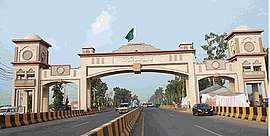 From top: Clock Tower, Bab-e-Sialkot | |
 Municipal Corporation logo | |
| Nickname(s): City of Iqbal | |
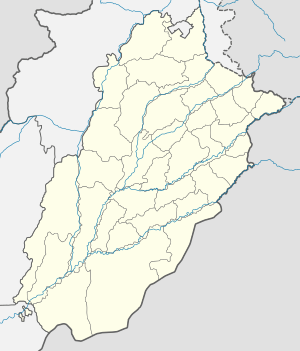 Sialkot Location in Pakistan 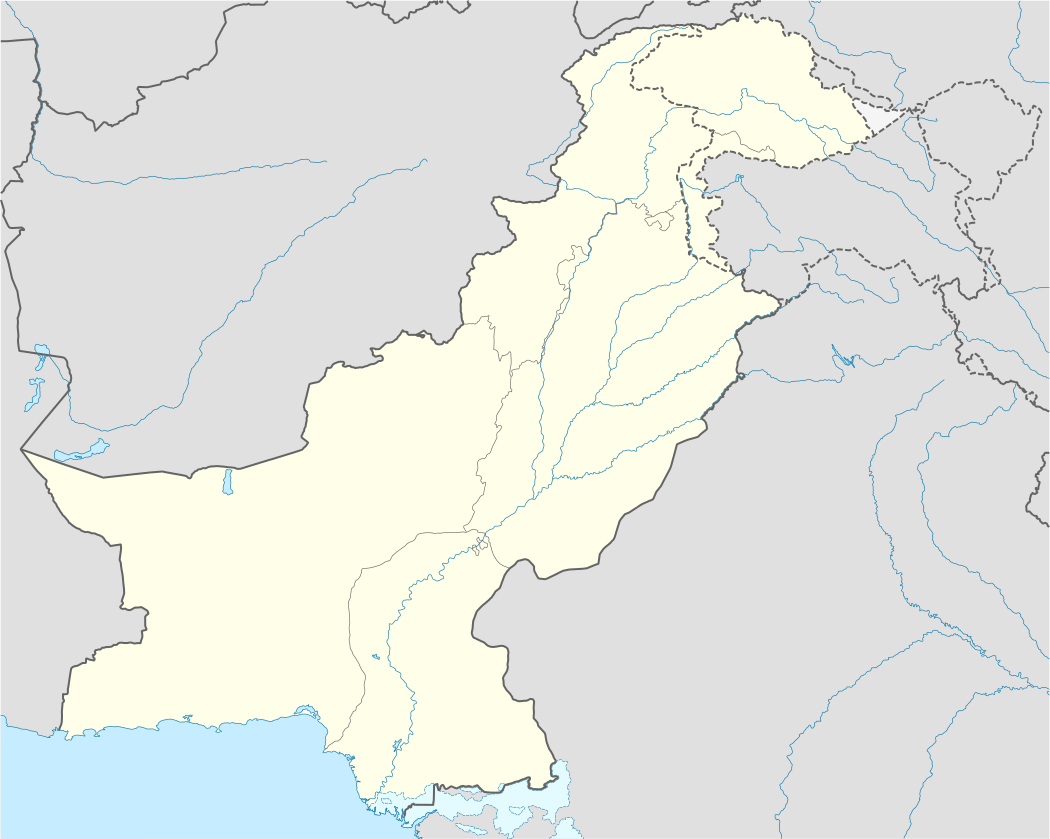 Sialkot Sialkot (Pakistan) | |
| Coordinates: 32°29′33″N 74°31′52″E | |
| Country | |
| Province | |
| Division | Gujranwala |
| District | Sialkot |
| Government | |
| • Type | Municipal Corporation |
| • Mayor | Toheed Akhtar Chaudhary |
| • Deputy Mayor | Chaudhary Bashir Ahmed |
| • Chief Officer | Muhammad Zafar Qureshi |
| Area | |
| • City | 102 km2 (39 sq mi) |
| • Metro | 3,016 km2 (1,164 sq mi) |
| Elevation | 256 m (840 ft) |
| Population | |
| • City | 655,852 |
| • Rank | 13th, Pakistan |
| • Density | 6,400/km2 (17,000/sq mi) |
| Demonym(s) | Sialkoti |
| Time zone | UTC+5 (PST) |
| Postal code | 51310 |
| Calling code | 052 |
| Old name | Sagala[4][5] or Sakala[6] |
| HDI (2014) | |
| Number of Union councils | 152 |
| Website | Municipal Corporation Sialkot |
Sialkot is believed to be site of ancient Sagala, a city razed by Alexander the Great in 326 BCE, and then made capital of the Indo-Greek kingdom by Menander I in the 2nd century BCE—a time during which the city greatly prospered as a major centre for trade and Buddhist thought.[11] Sialkot continued to be a major political centre, until it was eclipsed by Lahore around the turn of the first millennium.[12] The city rose again in prominence during the British era, and is now one of Pakistan's most important industrial centres.
Sialkot is wealthy relative to other cities in South Asia, with an estimated 2014 per capita income of $2800 (nominal).[13][14] The city has been noted by The Economist for its entrepreneurial spirit, and productive business climate that have made Sialkot an example of a small Pakistani city that has emerged as a "world-class manufacturing hub."[15] The relatively small city exported approximately $2 billion worth of goods in 2015, or about 10% of Pakistan's total exports.[15][16] Sialkot is also home to the Sialkot International Airport—Pakistan's first privately owned public airport.[15]
History
Ancient
Founding
Ambiguity regarding Sialkot's ancient history has resulted in the promulgation of various myths and legends to explain the city's origins.[17] One tradition states that the city was founded as the capital city of the Madra Kingdom by King Shalya - who served as a general in the central Kurukshetra War of the Mahabharata.
Greek
The first record of Sialkot dates from the invasion of Alexander the Great, who conquered upper Punjab in 326 BCE.[17] The Anabasis of Alexander, written by the Roman-Greek historian Arrian, recorded that Alexander captured ancient Sialkot, recorded as Sagala, from the Cathaeans, who had entrenched themselves there.[18][19] The city had been home to 80,000 residents on the eve of Alexander's invasion,[19] but was razed as a warning against any other nearby cities that might resist his invasion.[19]
Indo-Greek
The ancient city was rebuilt, and made capital by the Indo-Greek king Menander I, of the Euthydemid dynasty,[20] who ruled between 135 and 160 BCE. The rebuilt city was shifted slightly from the older city, as rebuilding on exactly the same spot was considered inauspicious.[21]
Under Menander's rule, the city greatly prospered as a major trading centre renowned for its silk.[11][17] Menander embraced Buddhism, in a process recorded in the Buddhist text Milinda Panha. The text offers an early description of the city's cityscape and status as a prosperous trade centre with numerous green spaces.[22] Following his conversion, Sialkot developed as a major centre for Buddhist though.[23]
Ancient Sialkot was recorded by Ptolemy in his 1st century CE work, Geography,[24][20] in which he refers to the city as Euthymedeia (Εύθυμέδεια).[25]
White Huns
Around 460 CE, the Hephthalites, also known as the White Huns, invaded the region from Central Asia,[26] forcing the ruling family of nearby Taxila to seek refuge in Sialkot.[27] Sialkot itself was soon captured, and the city was made capital of the Hephthalite Empire around 515,[28] during the reign of Toramana.[29] During the reign of his son, Mihirakula, the Hephthalite Empire reached its zenith.[30] The Hepthalites were defeated in 528 by a coalition of princes led by Prince Yasodhara.[29]
Late antiquity
The city was visited by the Chinese traveller Xuanzang in 633,[31] who recorded the city's name as She-kie-lo.[32] Xuanzang reported that the city had been rebuilt approximately 15 li, or 2.5 miles, away from the city ruined by Alexander the Great.[33] During this time, Sialkot served as the political nucleus of the Punjab region.[34] The city was then invaded in 643 by Rajput princes from Jammu, who held the city until the Muslim invasions during the medieval era.[35]
Medieval
Around the year 1000, Sialkot began to decline in importance as the nearby city of Lahore rose to prominence.[12] Following to fall of Lahore to the Ghaznavid Empire in the early 11th century, the capital of the Hindu Shahi empire was shifted from Lahore to Sialkot.[36] Ghaznavid expansion in northern Punjab encouraged local Khokhar tribes to stop paying tribute to the Rajas of Jammu.[37]
Sialkot became a part of the medieval Sultanate of Delhi after Muhammad Ghauri conquered Punjab in 1185.[34] Ghauri was unable to conquer the larger city of Lahore, but deemed Sialkot important enough to warrant a garrison.[38][17] He also extensively repaired the Sialkot Fort around the time of his conquest of Punjab,[37] and left the region in charge of Hussain Churmali while he returned to Ghazni.[39] Sialkot was then quickly laid siege to by Khokhar tribesmen,[40] and Khusrau Malik,[38] the last Ghaznavid sultan, though he was defeated during Ghauri's return to Punjab in 1186.[39][40]
In the 1200s, Sialkot was the only area of western Punjab that was ruled by the Mamluk Sultanate in Delhi.[41] The area had been captured by the Ghauri prince Yildiz, but was recaptured by Sultan Iltutmish in 1217.[41] Around 1223, Jalal ad-Din Mingburnu, the last king of the Khwarazmian dynasty of Central Asia that had fled invasion of Genghis Khan there, briefly captured Sialkot and Lahore,[42] before being driven out by Iltutmish's forces towards Uch Sharif.[43] During the 13th century, Imam Ali-ul-Haq, Sialkot's most revered Sufi warrior-saint,[44] arrived from Arabia, and began his missionary work in the region that successfully converted large numbers of Hindus to Islam, thereby transforming Sialkot into a largely Muslim city.[45] The saint later died in battle, and is revered as a martyr.[46]
Sialkot fell to Shaykha Khokhar around 1414.[47] Sialkot's population continued to grow in the 1400s under the rule of Sultan Bahlul Lodi, who had granted custodianship of the city to Jammu's Raja Biram Dev, after he helped Lodhi defeat the Khokhars.[47] Sialkot was sacked during the Lodhi period by Malik Tazi Bhat of Kashmir, who attacked Sialkot after the governor of Punjab, Tatar Khan, had left the city undefended during one of his military campaigns.[48]
Sialkot was captured by armies of the Babur in 1520,[49] when the Mughal commander Usman Ghani Raza advanced towards Delhi during the initial conquest of Babur. Babur recorded a battle with Gujjar raiders, who had attacked Sialkot, and allegedly mistreated its inhabitants.[50] In 1525-1526, Alam Khan, uncle of Sultan Ibrahim Lodi, invaded from Afghanistan, and was able to capture Sialkot with the aid of Mongol forces.[51]
Pre-modern
Mughal
During the early Mughal era, Sialkot was made part of the subah, or "province," of Lahore.[35] According to Sikh tradition, Guru Nanak, the founder of Sikhism, visited the city,[52] sometime in the early 16th century. He is said to have met Hamza Ghaus, a prominent Sufi mystic based in Sialkot, at a site now commemorated by the city's Gurdwara Beri Sahib.
During the Akbar era, Sialkot's pargana territory was placed in the jagir custodianship of Raja Man Singh, who would repair the city's fort, and sought to increase its population and develop its economy.[53] In 1580 Yousuf Shah Chak of Kashmir sought refuge in the city during his exile from the Valley of Kashmir.[54] Paper-makers from Kashmir migrated to the city during the Akbar period,[55] and Sialkot later became renowned as the source of the prized Mughal Hariri paper - known for its brilliant whiteness and strength.[46] The city's metalworkers also provided the Mughal crown with much of its weaponry.[56]
During the reign of Jahangir, the post was given to Safdar Khan, who rebuilt the city's fort, and oversaw a further increase in Sialkot's prosperity.[46] Numerous fine houses and gardens were built in the city during the Jehangir period.[57] During the Shah Jahan period, the city was placed under the rule of Ali Mardan Khan.[58]
The last great Mughal emperor, Aurangzeb, appointed Ganga Dhar as faujdar of the city until 1654.[59] Rahmat Khan was then placed in charge of the city, and would build a mosque in the city.[60] Under Aurangzeb's reign, Sialkot became known as a great centre of Islamic thought and scholarship,[61][62] and attracted scholars because of the widespread availability of paper in the city.[63]
Post-Mughal
Following the decline of the Mughal empire after the death of Emperor Aurangzeb in 1707, Sialkot and its outlying districts were left undefended and forced to defend itself. In 1739, the city was captured by Nader Shah of Persia during his invasion of the Mughal Empire.[64] The city was placed under the governorship of Zakariya Khan, the Mughal Viceroy of Lahore, who in return for the city promised to pay tribute to the Persian crown.[64]
In the wake of the Persian invasion, Sialkot fell under the control of Pashtun powerful families from Multan and Afghanistan - the Kakayzais and Sherwanis.[58] Sialkot was crept upon by Ranjit Deo of Jammu, who pledged nominal allegiance to the Mughal crown in Delhi.[58] Ranjit Deo did not conquer Sialkot city from the Pashtun families which held the city, but switched allegiance to the Pashtun ruler Ahmed Shah Durrani in 1748,[58] effectively ending Mughal influence in Sialkot. The city and three nearby districts were amalgamated into the Durrani Empire.[35]
Sikh
Sikh chieftains of the Bhangi Misl state encroached upon Sialkot, and had gained full control of the Sialkot region by 1786,[58].[47] Sialkot was portioned into 4 quarters, under the control of Sardar Jiwan Singh, Natha Singh, Sahib Singh, and Mohar Singh, who invited the city's dispersed residents back to the city.[47]
The Bhangi rulers engaged in feuds with the neighbouring Sukerchakia Misl state by 1791,[58] and would eventually lose control of the city. The Sikh Empire of Ranjit Singh captured Sialkot from Sardar Jiwan Singh in 1808.[64] Sikh forces then occupied Sialkot until the arrival of the British in 1849.[65]
Modern
British

Sialkot, along with Punjab as a whole, was captured by the British following their victory over the Sikhs at the Battle of Gujrat in February 1849. During the British era, an official is known as The Resident who would, in theory, advise the Maharaja of Kashmir would reside in Sialkot during the wintertime.[66]
During the Sepoy Mutiny of 1857, the two Bengal regiments based in Sialkot rebelled against the East India Company,[67] while their native servants also took up arms against the British.[68] In 1877, the Sialkot poet Allama Iqbal, who is credited for inspiring the Pakistan Movement, was born into a Kashmiri family that had converted to Islam from Hinduism in the early 1400s.[69] British India's first bagpipe works opened in Sialkot, and today there are 20 pipe bands in the city.[70]
Sialkot's modern prosperity began during the colonial era.[71] The city had been known for its paper making and ironworks prior to the colonial era,[71] and became a centre of metalwork in the 1890s. Surgical instruments were being manufactured in Sialkot for use throughout British India by the 1920s.[72] The city also became a centre for sports goods manufacturing for British troops stationed along with the North West Frontier due to the availability of nearby timber reserves.[71]
As a result of the city's prosperity, large numbers of migrants from Kashmir came to the city in search of employment.[71] At the end of World War 2, the city was considered the second most industrialised in Punjab, after Amritsar.[71] Much of the city's infrastructure was paid for by local taxes,[71] and the city was one of the few in British India to have its own electric utility company.[71]
Partition
The first communal riots between Hindus/Sikhs and Muslims took place on 24 June 1946,[73] a day after the resolution calling for the establishment of Pakistan as a separate state. Sialkot remained peaceful for several months while communal riots had erupted in Lahore, Amritsar, Ludhiana, and Rawalpindi.[73] The predominantly Muslim population supported Muslim League and the Pakistan Movement.
While Muslim refugees had poured into the city escaping riots elsewhere, Sialkot's Hindu and Sikh communities began fleeing in the opposite direction towards India.[73] They initially congregated in fields outside the city, where some of Sialkot's Muslims would bid farewell to departing friends.[73] Hindu and Sikh refugees were unable to exit Pakistan towards Jammu on account of conflict in Kashmir, and were instead required to transit via Lahore.[73]
Post-independence
After independence in 1947 the Hindu and Sikh minorities migrated to India, while Muslim refugees from India settled in Sialkot. The city had suffered significant losses as a result of communal rioting that erupted because of Partition.[13] 80% of Sialkot's industry had been destroyed or abandoned, and the working capital fell by an estimated 90%.[13] The city was further stressed by the arrival of 200,000 migrants, mostly from Jammu,[13] who had arrived in the city.[13]
Following the demise of industry in the city, the government of West Pakistan prioritized the re-establishment of Punjab's decimated industrial base.[13] The province lead infrastructure projects in the area, and allotted abandoned properties to newly arrived refugees.[13] Local entrepreneurs also rose to fill the vacuum created by the departure of Hindu and Sikh businessmen.[72][13] By the 1960s, the provincial government laid extensive new roadways in the district, and connected it to trunk roads to link the region to the seaport in Karachi.[13]
During the Indo-Pakistani war of 1965, when Pakistani troops arrived in Kashmir, the Indian Army counterattacked in the Sialkot Sector. The Pakistan Army successfully defended the city and the people of Sialkot came out in full force to support the troops.[74] In 1966, Government of Pakistan awarded a special flag of Hilal-e-Istaqlal to Sialkot, alongwith Lahore and Sargodha in Indo-Pakistani War of 1965 for showing severe resistance in front of enemy as these cities were target of enemy's advances.[75] Every year on Defence Day, this flag is hoisted in these cities as a symbol of recognition of the will, courage and perseverance of the dwellers of these cities.[76] The armoured battles in the Sialkot sector like the Battle of Chawinda were the most intense since the Second World War.[77]
Geography
Climate
Sialkot features a humid subtropical climate (Cwa) under the Köppen climate classification, with four seasons. The post-monsoon season from mid-September to mid-November remains hot during the daytime, but nights are cooler with low humidity. In the winter from mid-November to March, days are mild to warm, with occasionally heavy rainfalls occurring. Temperatures in winter may drop to 0 °C or 32 °F, but maxima are very rarely less than 15 °C or 59 °F.
| Climate data for Sialkot, Pakistan | |||||||||||||
|---|---|---|---|---|---|---|---|---|---|---|---|---|---|
| Month | Jan | Feb | Mar | Apr | May | Jun | Jul | Aug | Sep | Oct | Nov | Dec | Year |
| Record high °C (°F) | 26.1 (79.0) |
30.0 (86.0) |
35.0 (95.0) |
42.2 (108.0) |
47.3 (117.1) |
48.9 (120.0) |
44.4 (111.9) |
41.1 (106.0) |
39.0 (102.2) |
37.2 (99.0) |
33.3 (91.9) |
27.2 (81.0) |
48.9 (120.0) |
| Average high °C (°F) | 18.5 (65.3) |
21.0 (69.8) |
25.7 (78.3) |
32.8 (91.0) |
38.0 (100.4) |
39.9 (103.8) |
34.9 (94.8) |
33.6 (92.5) |
33.6 (92.5) |
31.7 (89.1) |
26.1 (79.0) |
20.1 (68.2) |
29.7 (85.5) |
| Daily mean °C (°F) | 11.6 (52.9) |
13.8 (56.8) |
18.6 (65.5) |
25.0 (77.0) |
30.0 (86.0) |
32.2 (90.0) |
29.8 (85.6) |
29.0 (84.2) |
27.9 (82.2) |
23.7 (74.7) |
17.8 (64.0) |
12.8 (55.0) |
22.6 (72.7) |
| Average low °C (°F) | 5.0 (41.0) |
7.1 (44.8) |
11.8 (53.2) |
17.3 (63.1) |
22.0 (71.6) |
25.1 (77.2) |
25.1 (77.2) |
24.8 (76.6) |
22.3 (72.1) |
16.0 (60.8) |
9.6 (49.3) |
5.6 (42.1) |
16.0 (60.8) |
| Record low °C (°F) | −1.1 (30.0) |
−1.0 (30.2) |
3.0 (37.4) |
9.0 (48.2) |
13.4 (56.1) |
18.0 (64.4) |
19.5 (67.1) |
18.7 (65.7) |
13.3 (55.9) |
8.5 (47.3) |
3.0 (37.4) |
−0.6 (30.9) |
−1.1 (30.0) |
| Average rainfall mm (inches) | 41.1 (1.62) |
43.8 (1.72) |
53.7 (2.11) |
30.1 (1.19) |
28.0 (1.10) |
65.6 (2.58) |
312.6 (12.31) |
259.1 (10.20) |
94.1 (3.70) |
14.5 (0.57) |
9.1 (0.36) |
30.4 (1.20) |
982.1 (38.66) |
| Source: NOAA (1971–1990)[78] | |||||||||||||
Cityscape
Sialkot's core is composed of the densely populated Old City, while northeast of the city lies the vast colonial era Sialkot Cantonment - characterized by wide streets and large lawns. The city's industries have developed in a "ribbon-like" pattern along the cities main arteries,[13] and are almost entirely dedicated to export.[13] The city's sporting good firms are not concentrated in any part of the city, but are instead spread throughout Sialkot.[13] Despite the city's overall prosperity, the local government has failed to meet Sialkot's basic infrastructure needs.[79]
Economy
_Ltd%2C_Khitchian%2C_Sialkot_-_panoramio.jpg) Kampala Industries, Sialkot
Kampala Industries, Sialkot- Ennoble International, Sialkot
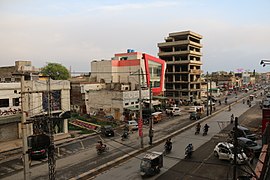 Shopping area in Sialkot
Shopping area in Sialkot
Sialkot is a wealthy city relative to the rest of Pakistan and South Asia,[72] with a per capita income in 2014 estimated at $2800.[13] The city was considered to be one of British India's most industrialised cities,[13] though its economy would later be largely decimated by violence and capital flight following the Partition.[13] The city's economy rebounded, and Sialkot now forms part of the relatively industrialised region of northern Punjab that is sometimes referred to as the Golden Triangle.[10]
Sialkot has been noted by Britain's The Economist magazine as a "world-class manufacturing hub" with strong export industries.[15] As of 2015, Sialkot exported US$2 billion worth of goods which is equal to 9% of Pakistan's total exports (US$22 billion).[80] 250,000 residents are employed in Sialkot's industries,[13] with most enterprises in the city being small and funded by family savings.[79] Sialkot's Chamber of Commerce had over 6,500 members in 2010, with most active in the leather, sporting goods, and surgical instruments industry.[79] The Sialkot Dry Port offers local producers quick access to Pakistani Customs, as well as to logistics and transportation.[15]

Despite being cut off from its historic economic heartland in Kashmir, Sialkot has managed to position itself into one of Pakistan's most prosperous cities, exporting up to 10% of all Pakistani exports.[15] Its sporting goods firms have been particularly successful, and have produced items for global brands such as Nike, Adidas, Reebok, and Puma.[13] Balls for the 2014 FIFA World Cup were made in Sialkot.[81]
Sialkot's business community has joined with the local government to maintain the city's infrastructure, as the local government has limited capacity to fund such maintenance.[13] The business community was instrumental in the establishment of Sialkot's Dry Port in 1985,[79] and further helped re-pave the city's roads.[15] Sialkot's business community also largely funded the Sialkot International Airport—opened in 2011 as Pakistan's first privately owned public airport,[15] which now offers direct flights from Sialkot to Bahrain, Oman, Qatar, Saudi Arabia, and the United Arab Emirates.
Industry
Sialkot is the world's largest producer of hand-sewn footballs, with local factories manufacturing 40~60 million footballs a year, amounting to roughly 60% of world production.[82] The 2014 FIFA World Cup's footballs were made by Forward Sports, a company based in Sialkot.[81] Clustering of sports goods industrial units has allowed for firms in Sialkot to become highly specialised, and to benefit from joint action and external economies.[83] There is a well-applied child labour ban, the Atlanta Agreement, in the industry since a 1997 outcry,[84] and the local industry now funds the Independent Monitoring Association for Child Labour to regulate factories.[79]
Sialkot is also the world's largest centre of surgical instrument manufacturing.[85] Sialkot was first noted to be a centre of metalwork in the 1890s, and the city's association with surgical instruments came from the need to repair, and subsequently manufacture, surgical instruments for the nearby Mission hospital.[72] By the 1920s, surgical instruments were being manufactured for use throughout British India,[72] with demand boosted by further by World War Two.[72]
The city's surgical instrument manufacturing industry benefits from a clustering effect, in which larger manufacturers remain in close contact with smaller and specialized industries that can efficiently perform contracted work.[72] The industry is made up of a few hundred small and medium size enterprises, supported by thousands of subcontractors, suppliers, and those providing other ancillary services.[72] The bulk of exports are destined for the United States and European Union.[72]
Sialkot first became a centre for sporting goods manufacturing during the colonial era. Enterprises were initially established for the recreation of British troops stationed along the North West Frontier.[13] Nearby timber reserves served to initially attract the industry to Sialkot.[13] The city's Muslim craftsmen generally manufactured the goods, while Sikh and Hindu merchants of the Sindhi Bania, Arora, and Punjabi Khatri castes acted like middle men to bring goods to market.[13] Sialkot now produces a wide array of sporting goods, including footballs and hockey sticks.[15]
Sialkot is also noted for its leather goods. Leather for footballs is sourced from nearby farms,[79] while Sialkot's leather workers craft some of Germany's most prized leather lederhosen trousers.[15]
Public-Private Partnerships
Sialkot has a productive relationship between the civic administration and the city's entrepreneurs,[86] that dates to the colonial era. Sialkot's infrastructure was paid for by local taxes on industry,[13] and the city was one of the few in British India to have its own electric utility company.[13]
Modern Sialkot's business community has assumed responsibility for developing infrastructure when the civic administration is unable to deliver requested services.[15] The city's Chamber of Commerce established the Sialkot Dry Port, the country's first dry-port in 1985 to reduce transit times by offering faster customs services.[15] Members of the Chamber of Commerce allowed paid fees in order to help resurface the city's streets.[15] The Sialkot International Airport was established by the local businesses community, is the only private airport in Pakistan.[80] The airport now offers flights throughout Pakistan, and several Persian Gulf countries.
Transportation
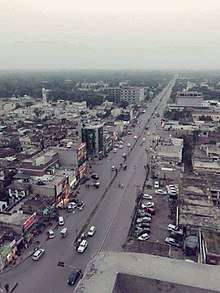
Motorways
A dual-carriageway connects Sialkot to the nearby City of Wazirabad, with onwards connections throughout Pakistan via the N-5 National Highway, while another dual carriageway connects Sialkot to Daska, and onwards to Gujranwala and Lahore. Sialkot and Lahore are also connected through the motorway (M11), which is the north-south motorway in Punjab. The total length of this motorway is 103 km. It was completely opened on 18 March 2020 at the cost of 44 billion rupees. It has reduced the travel time between Sialkot and Lahore to 50 minutes from two hours (through the other route via N5/GT).
Rail
Sialkot Junction railway station is the city's main railway station and is serviced by the Wazirabad–Narowal Branch Line of the Pakistan Railways.
Air
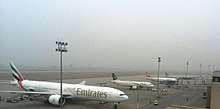
Sialkot International Airport is located 8.7 east of the city in the town of Sambrial. It was established in 2007 by spending 4 billion rupees by Sialkot business community. It is Pakistan's only privately owned public airport[15] and offers flights throughout Pakistan with also direct flights to Bahrain, Oman, Saudi Arabia, Qatar, United Arab Emirates, France, UK and Spain.
Air Sial
Sialkot International Airport has launched their own airline named AirSial. It was founded in October 2017 by Sialkot Chamber of Commerce and Industry.
Notable people
Sister cities


See also
References
- "MC Sialkot: Administrative Setup". Local Government Punjab. Retrieved 27 April 2018.
- "POPULATION AND HOUSEHOLD DETAIL FROM BLOCK TO DISTRICT LEVEL: PUNJAB (SIALKOT DISTRICT)" (PDF). Pakistan Bureau of Statistics. 3 January 2018. Retrieved 27 April 2018.
- "Pakistan: Provinces and Major Cities - Population Statistics, Maps, Charts, Weather and Web Information". www.citypopulation.de.
- Abdul Majeed Abid (28 December 2015). "Pakistan's Greek connection". The Nation. Retrieved 17 March 2017.
- Tarn, William Woodthorpe. The Greeks in Bactria and India. Cambridge University Press. p. 171. ISBN 9781108009416. Retrieved 17 March 2017.
- Mushtaq Soofi (18 January 2013). "Ravi and Chenab: demons and lovers". DAWN.COM. Retrieved 17 March 2017.
- "SOCIAL DEVELOPMENT IN PAKISTAN ANNUAL REVIEW 2014–15" (PDF). SOCIAL POLICY AND DEVELOPMENT CENTRE. 2016. Retrieved 26 March 2017.
- "Pakistan City & Town Population List". Tageo.com website. Retrieved 29 September 2017.
- Azhar, Annus; Adil, Shahid. "Effect of Agglomeration on Socio-Economic Outcomes: A District Level Panel study of Punjab" (PDF). Pakistan Institute of Developmental Economics. Retrieved 2 June 2017.
- Mehmood, Mirza, Faisal; Ali, Jaffri, Atif; Saim, Hashmi, Muhammad (21 April 2014). An assessment of industrial employment skill gaps among university graduates: In the Gujrat-Sialkot-Gujranwala industrial cluster, Pakistan. Intl Food Policy Res Inst. p. 2.
- McEvilley, Thomas (2012). The Shape of Ancient Thought: Comparative Studies in Greek and Indian Philosophies. Skyhorse Publishing. ISBN 9781581159332. Retrieved 2 June 2017.
- Man & Development. Centre for Research in Rural and Industrial Development. 2007.
- Anwar, Nausheen (2014). Infrastructure Redux: Crisis, Progress in Industrial Pakistan & Beyond. Springer. ISBN 9781137448170. Retrieved 11 October 2017.
- Ghani, Faras. "The Story of Football". Al Jazeera. Retrieved 11 October 2017.
- "Pakistan's business climate If you want it done right". The Economist. 27 October 2017. Retrieved 2 June 2017.
- Naz, Neelum. "Historical Perspective of Urban Development of Gujranwala". Dept. of Architecture, UET, Lahore. Retrieved 22 December 2017.
- Dhillon, Harish (2015). Janamsakhis: Ageless Stories, Timeless Values. Hay House, Inc. ISBN 9789384544843. Retrieved 3 June 2017.
- Arrian (1884). The Anabasis of Alexander, Or the History of the Wars and Conquests of Alexander the Great. Hodder and Stoughton.
- Yenne, Bill (13 April 2010). Alexander the Great: Lessons from History's Undefeated General. St. Martin's Press. ISBN 9780230106406.
- Tarn, William Woodthorpe (24 June 2010). The Greeks in Bactria and India. Cambridge University Press. ISBN 9781108009416.
- Wilson, Horace Hayman; Masson, Charles (1841). Ariana Antiqua: A Descriptive Account of the Antiquities and Coins of Afghanistan. East India Company.
- Davids, Thomas William Rhys (1894). The Questions of King Milinda. Clarendon Press.
- McEvilley, Thomas (7 February 2012). The Shape of Ancient Thought: Comparative Studies in Greek and Indian Philosophies. Skyhorse Publishing, Inc. ISBN 9781581159332.
- Journal of Indian History. 1960.
- Cohen, Getzel M. (2 June 2013). The Hellenistic Settlements in the East from Armenia and Mesopotamia to Bactria and India. University of California Press. ISBN 9780520953567.
- Kim, Hyun Jin; Vervaet, Frederik Juliaan; Adalı, Selim Ferruh (30 September 2017). Eurasian Empires in Antiquity and the Early Middle Ages: Contact and Exchange between the Graeco-Roman World, Inner Asia and China. Cambridge University Press. ISBN 9781108121316.
- Nanda, J. N. (2010). History of the Punjabees. Concept Publishing Company. ISBN 9788180696510.
- Kulke, Hermann; Rothermund, Dietmar (27 May 2016). A History of India. Routledge. ISBN 9781317242123.
- Drachenfels, Dorothee von; Luczanits, Christian; Deutschland, Kunst-und Ausstellungshalle der Bundesrepublik (2008). Gandhara, the Buddhist heritage of Pakistan: Legends, monasteries, and paradise. Kunst- und Ausstellungshalle der Bundesrepublik Deutschland ; Mainz : Verlag Philipp von Zabern. ISBN 9783805339575.
- Dani, Ahmad Hasan (1999). History of Civilizations of Central Asia: The crossroads of civilizations: A.D. 250 to 750. Motilal Banarsidass. ISBN 9788120815407.
- Wriggins, Sally (6 August 2008). The Silk Road Journey With Xuanzang. Basic Books. ISBN 9780786725441.
- Bakker, Hans (16 July 2014). The World of the Skandapurāṇa. BRILL. ISBN 9789004277144.
- Four Reports Made During the Years 1862-63-64-65 by Alexander Cunningha M: 2. Government central Press. 1871.
- Chakrabarty, Dilip K. (18 October 2010). The Geopolitical Orbits of Ancient India: The Geographical Frames of the Ancient Indian Dynasties. Oxford University Press. ISBN 9780199088324.
- Hunter, Sir William Wilson (1887). The Imperial Gazetteer of India. Trübner & Company.
- Bosworth, C. Edmund (2007). Historic Cities of the Islamic World. Brill. ISBN 9047423836. Retrieved 26 December 2017.
- Wink, André (1997). Al-Hind the Making of the Indo-Islamic World: The Slave Kings and the Islamic Conquest : 11Th-13th Centuries. BRILL. ISBN 9004102361.
- Mehta, Jaswant Lal (1980). Advanced Study in the History of Medieval India, Volume 1. Sterling Publishers Pvt. Ltd. ISBN 9788120706170. Retrieved 3 June 2017.
- Firishtah, Muḥammad Qāsim Hindū Shāh Astarābādī (2003). The history of Hindustan. Vol. 1. Motilal Banarsidass. ISBN 9788120819948.
- Khan, Iqtidar Alam (25 April 2008). Historical Dictionary of Medieval India. Scarecrow Press. ISBN 9780810855038.
- Sandhu, Gurcharn Singh (January 2003). A military history of medieval India. Vision Books.
- Sharma, L. P. (1987). History of medieval India (1000-1740 A.D.). Konark Publishers.
- Bosworth, C. Edmund (26 December 2007). Historic Cities of the Islamic World. BRILL. ISBN 9789047423836.
- Hasan, Masudul (1965). Hand Book of Important Places in West Pakistan. Pakistan Social Service Foundation.
- Pakistan Pictorial. Pakistan Publications. 1986.
- Afsos, Sher ʻAlī Jaʻfarī (1882). The Arāīs̲h-i-maḥfil: Or, The Ornament of the Assembly. J. W. Thomas, Baptist Mission Press.
- Grewal, J. S.; Banga, Indu (22 December 2015). Early Nineteenth-Century Panjab. Taylor & Francis. ISBN 9781317336945.
- Medieval Kashmir. Atlantic Publishers & Distri.
- Ahmed, Farooqui Salma (2011). A Comprehensive History of Medieval India: Twelfth to the Mid-Eighteenth Century. Pearson Education India. ISBN 9788131732021. Retrieved 3 June 2017.
-
29th December: We dismounted at Sialkot. If one enters Hindustan the Jats and Gujjars always pour down in countless hordes from hill and plain for loot of bullocks and buffalo. These ill-omened peoples are senseless oppressors. Previously, their deeds did not concern us because the territory was an enemy's. But they did the same senseless deeds after we had captured it. When we reached Sialkot, they swooped on the poor and needy folk who were coming out of the town to our camp and stripped them bare. I had the witless brigands apprehended, and ordered a few of them to be cut to pieces.'Babur Nama page 250 published by Penguin
- al-Harawī, Niʻmatallāh (1829). History of the Afghans. Oriental Translation-Fund.
- Dhillon, Iqbal S. (1998). Folk Dances of Panjab. Delhi: National Book Shop.
- Quddus, Syed Abdul (1992). Punjab, the land of beauty, love, and mysticism. Royal Book Co.
- Khan, Refaqat Ali (1976). The Kachhwahas under Akbar and Jahangir. Kitab Pub. House.
- Khan, Ahmad Nabi (1977). Iqbal Manzil, Sialkot: An Introduction. Department of Archaeology & Museums, Government of Pakistan.
- Elphinstone, Mountstuart (2008). Aurangzeb. Oxford University Press. ISBN 9780195475753.
- Khan, Ahmad Nabi (1977). Iqbal Manzil, Sialkot: An Introduction. Department of Archaeology & Museums, Government of Pakistan.
- Cotton, James Sutherland; Burn, Sir Richard; Meyer, Sir William Stevenson (1908). Imperial Gazetteer of India ... Clarendon Press.
- Singh, Chetan (1991). Region and empire: Panjab in the seventeenth century. Oxford University Press.
- Khan, Ahmad Nabi (1977). Iqbal Manzil, Sialkot: An Introduction. Department of Archaeology & Museums, Government of Pakistan.
- Rajput, J. S.; (India), National Council of Educational Research and Training (2004). Encyclopaedia of Indian Education: A-K. NCERT. ISBN 9788174503039.
- The Pakistan Review. Ferozsons Limited. 1968.
- Sahay, Binode Kumar (1968). Education and learning under the great Mughals, 1526-1707 A.D. New Literature Pub. Co.
- bahādur.), Muḥammad Laṭīf (Saiyid, khān (1891). History of the Panjáb from the Remotest Antiquity to the Present Time. Calcutta Central Press Company, limited.
- Zutshi, Chitralekha (2003), Language of belonging: Islam, regional identity, and the making of Kashmir, Oxford University Press/Permanent Black. Pp. 359, ISBN 978-0-19-521939-5
- Ingall, Francis (1989). The Last of the Bengal Lancers. Pen and Sword. ISBN 9781473815872. Retrieved 11 October 2017.
- Wagner, Kim A. The Skull of Alum Beg. The Life and Death of a Rebel of 1857. p. 105. ISBN 978-0-19-087023-2.
- Kaye, John (2010). Kaye's and Malleson's History of the Indian Mutiny of 1857-8. Cambridge University Press. ISBN 9781108023245. Retrieved 11 October 2017.
- Mir, Mustansir (2006). Iqbal: Makers of Islamic Civilization. I.B.Tauris. ISBN 9781845110949.
- "Punjab pays tartan homage to Caledonia | World news | The Observer". Guardian. 25 April 2004. Retrieved 22 November 2013.
- Nausheen Anwar (2014). Infrastructure Redux: Crisis, Progress in Industrial Pakistan & Beyond. Pakistan: Palgrave Macmillan. p. 119. ISBN 978-1-137-44818-7.
- Nadvi, Khalid (October 1997). "KNOWING ME, KNOWING YOU: Social networks in the surgical instrument cluster of Sialkot, Pakistan" (PDF). Retrieved 11 October 2017. Cite journal requires
|journal=(help) - Nahal, Chaman (2001). Azadi. Penguin Books India. ISBN 9780141007502.
- K Conboy, "Elite Forces of India and Pakistan" ISBN 1-85532-209-9, page 9
- https://tribune.com.pk/story/601035/commemorating-sept-1965-nation-celebrates-defence-day-with-fervour/?amp=1
- https://www.dawn.com/news/56110/defence-day-celebrated-with-renewed-pledges
- The India-Pakistan Air War of 1965, Synopsis. Retrieved 26 May 2008 at the Internet Archive
- "Sialkot Climate Normals 1971–1990". National Oceanic and Atmospheric Administration. Retrieved 16 January 2013.
- Dinh, Hinh (2011). Tales from the Development Frontier: How China and Other Countries Harness Light Manufacturing to Create Jobs and Prosperity. World Bank. ISBN 9780821399897.
- "How a small Pakistani city became a world-class manufacturing hub". The Economist. 29 October 2016. Retrieved 29 October 2016.
- http://www.thenews.com.pk/article-150235-Brazilian-ambassador-unveils-Pak-made-FIFA-soccer-ball
- Eriksen, Thomas Hylland (2007). Globalization: The Key Concepts. Berg. ISBN 9781847886101. Retrieved 11 October 2017.
- Jovanović, Miroslav N., ed. (2007). Economic integration and spatial location of firms and industries: transnational corporations and search for evidence. Edward Elgar. p. 468. ISBN 9781845425838. Retrieved 11 October 2017.
- Hasnain Kazim (16 March 2010). "The Football Stitchers of Sialkot". Spiegel International. Retrieved 7 November 2011.
- "BMA - Fair Medical Trade". www.fairmedtrade.org.uk. Archived from the original on 8 March 2012. Retrieved 3 September 2017.
- "If you want it done right". The Economist. Retrieved 1 February 2018.
External links
| Wikimedia Commons has media related to Sialkot (Pakistan). |